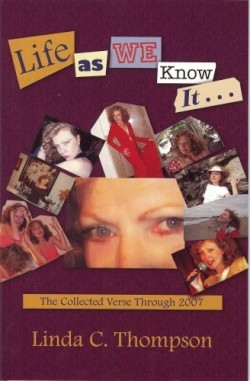It looks like you've stumbled upon a page meant to be read by our code instead of viewed directly. You're probably looking for this page.
Life As We Know It
“When the artist is alive in any person, whatsoever his kind of work may be, he becomes an inventive, searching, daring, self-expressive creature. He becomes interesting to other people. He disturbs, upsets, enlightens, and opens ways for better understanding.” Linda C. Thompson opens her book of poems, Life As We Know It, with this quote from the painter Robert Henri.
Although Thompson mistakenly refers to Henri as a nineteenth-century philosopher, his quote is still a perfect introduction to her book of poetry. Her collection consists of ninety-three pages divided into three separate sections: “One Step At Time,” “Love, Lust and Learning,” and finally, “Anima.” Life As We Know It shows the reader that Thompson, like the poets Erica Jong, Anne Sexton, Brenda Hillman, and Jorie Graham is an “inventive, searching, daring, self-expressive creature.”
Readers can follow her progression from a girl with skillful powers of observation who has just discovered that shades of gray exist between black and white decisions; into a woman in love and in the full bloom of her sensuality and sexuality.
Thompson has pet words and phrases and a propensity to use words bunched together with the -ing suffix, which creates a present tense. Sometimes this technique succeeds, but when overused, the impact of the verse is lessened. However, her prowess as a commentator and documenter of the human condition becomes more powerful as the book progresses. Her voice evolves as she is immersed further in life experiences. For example, in the second stanza of her first poem “We Do,” she writes, “And each aching step / we take / Accepts its yesterdays / Bound / Gagged / Straining / Toward inarticulate tomorrows.” Here, Thompson is like a fledgling just starting to explore her environment. She tentatively touches on bits and pieces of what she considers a relatively unspoken thought. To her the ideas of “inarticulate tomorrows “ is brand new, while to some readers “inarticulate tomorrows” are a given. The reader can sense her glee and wonder at the power of words to define an indefinable universe and her magical journey as a poet into profundity.
Thompson moves beyond the obvious in the section, “Love, Lust and Learning.” Her tropes and motifs radically change as she falls in love and a woman bursts from the confines of the expectations and fairy-tale dreams of a little girl’s heart. In the final stanza of “A Friend Named Walt,” she writes, “Sensuality whispers in / The nurturing touch of understanding / becomes a caress. / In the decision before passion, / I look for my friend named Walt.”
In the last section, “Anima,” Thompson comes full circle. She revisits old themes with wiser eyes. “Anima” is a balance for her youthful idealism from “One Step At A Time” and the passionate woman from “Love, Lust and Learning.” For example, in the last stanza of “Love Comes,” she writes:
In this moment
Love comes,
Softly pouring, wet,
soaking and coating
Or drying and fulfilling
Like a deep breath
of tingling light.
And a gift of realization
That it will always be
and has always been.
Life As We Know It is grand start for Thompson’s contribution to the canon of twenty-first-century women poets.
Disclosure: This article is not an endorsement, but a review. The publisher of this book provided free copies of the book and paid a small fee to have their book reviewed by a professional reviewer. Foreword Reviews and Clarion Reviews make no guarantee that the publisher will receive a positive review. Foreword Magazine, Inc. is disclosing this in accordance with the Federal Trade Commission’s 16 CFR, Part 255.
